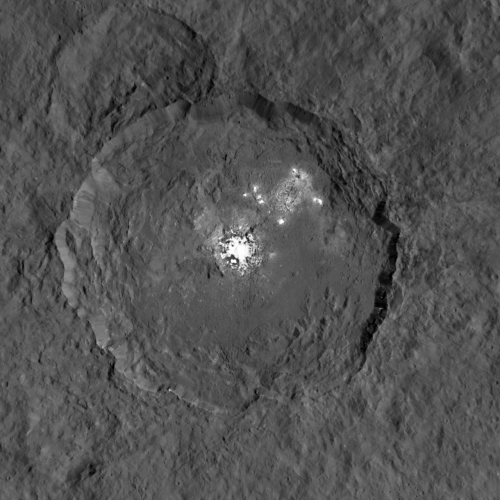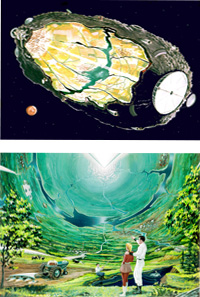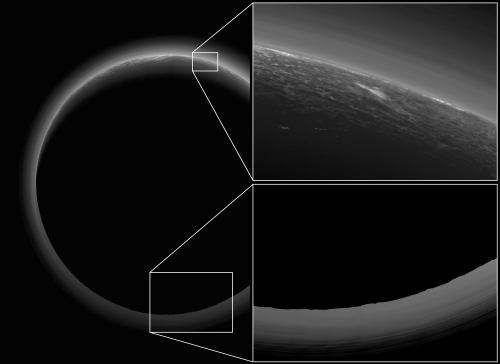Centauri Dreams
Imagining and Planning Interstellar Exploration
Asteroids as Spacecraft
Rama is a name that resonates with science fiction fans who remember Arthur C. Clarke’s wonderful Rendezvous with Rama (1973). The novel depicts a 50-kilometer starship that enters the Solar System and is intercepted by a human crew, finding remarkable and enigmatic things that I will leave undescribed for the pleasure of those who haven’t yet read the book. Suffice it to say that among Clarke’s many fine novels, Rendezvous with Rama is, along with The City and the Stars, a personal favorite.
What a company called Made in Space Inc. has in mind is something different than Clarke’s vision, though it too evokes names from the past, as we’ll shortly see. Based in Mountain View, CA the company is embarking on an attempt to turn asteroids into small spacecraft that can move themselves to new trajectories. RAMA in this case stands for Reconstituting Asteroids into Mechanical Automata, and it proceeds by putting ‘Seed Craft’ on asteroids that will use materials found on the surface. This is the kind of in situ resource utilization (ISRU) that Ian Crawford discussed in his essay in these pages last Friday.
A suitably modified asteroid could take itself to the nearest extraction point for human mining, while the seed craft could be sent on to another asteroid. Build the system right, Made in Space believes, and you can do away with at least some of the human control needed for space operations. 3-D printing plays a big role here, no surprise given the company’s background in providing the first such printer (to the ISS in 2014) that can function in zero-g. Our friend Jon Lomberg worked with Made in Space to create a ‘Golden Plate’ commemorating the first space manufacturing operation, now attached internally to the functioning space printer.
That name from the past I mentioned above is Dandridge Cole, an aerospace engineer, former paratrooper and futurist whose death in 1965 at the young age of 44 cost the space community one of its true visionaries. Cole had plenty of ideas of his own on moving asteroids, but in his case, the idea involved more than robotic transfer into a new orbit. Much more. Why not, thought Cole, actually hollow out an asteroid to create an internal habitat? Here’s how Alex Michael Bonnici described Cole’s idea in a tribute written in 2007:
In 1963, Cole wrote Exploring the Secrets of Space: Astronautics for the Layman with I. M. Levitt. In this book they suggested hollowing out an ellipsoidal asteroid about 30 km long, and rotating it about its major axis to simulate gravity. By reflecting sunlight inside with mirrors, and creating, on its inner surface, a pastoral setting an asteroid could be transformed into a permanent space colony. Cole and Cox also envisioned that asteroids would provide the raw materials to form the basis of a spacefaring civilization. And, that asteroidal materials would also serve terrestrial needs. In their view these materials could be transported using mass drivers or linear motors. Cole’s work largely presages that of Gerard K. O’Neill by more than a decade.
Image: Aerospace engineer and futurist Dandridge Cole, who coined the term ‘macro-life’ to refer to human colonies in space and their evolution. Credit: Wikimedia Commons.
Hollow asteroids are an idea familiar to science fiction fans, who will have encountered the trope in various short stories and perhaps in George Zebrowski’s 1979 novel Macrolife. The name is carefully chosen because Cole used ‘macro-life’ to describe future human evolution within space habitats like these, a development he thought would involve a life-form incorporating technology and intimately synchronized with its environment. Putting large colonies of hollow asteroids into play would ensure our species’ survival while allowing us to progress, he believed, beyond dangers like nuclear proliferation and population pressure.
Here’s Cole in 1961, from an essay called “The Ultimate Human Society”:
This concept of a new life form which I call Macro Life and Isaac Asimov calls ‘multiorganismic life’ serves as a convenient shorthand whereby the whole collection of social, political, and biological problems facing the future space colonist may be represented with two-word symbols. It also communicates quickly an appreciation for the similar problems which are rapidly descending on the whole human race. Macro Life can be defined as ‘life squared per cell.’ Taking man as representative of multicelled life we can say that man is the mean proportional between Macro Life and the cell, or Macro Life is to man as man is to the cell. Macro Life is a new life form of gigantic size which has for its cells individual human beings, plants, animals and machines.”
Arthur Clarke liked the notion enough to call Zebrowski’s novel ‘a worthy successor to Olaf Stapledon’s Star Maker,’ which had been a major influence on Clarke and most of his contemporaries. As to the notion of moving asteroids about, an early treatment was Robert Heinlein’s ‘Misfit,’ in which an asteroid is moved out of the main belt to an orbit between Mars and the Earth. This one made its appearance in the November 1939 issue of Astounding Science Fiction, and would hardly be the last asteroid-themed tale. A more modern take shows up in Larry Niven’s Known Space stories and the memorable ‘Belters.’
Image: An engineered asteroid from without and within. Illustrator Roy Scarfo worked with Cole on the 1965 book Beyond Tomorrow. Credit: Roy Scarfo.
We’ve come a long way from Made in Space and their plans to move asteroids through ‘seed craft’ and in situ resource utilization, but what I find exciting here is the synergy between some of these ideas from the past and the conceptual studies Made in Space is performing, with help from NASA’s Innovative Advanced Concepts Program. Asteroid mining gives us a route forward as we contemplate infrastructures within the Solar System, building, we can hope, toward a society comfortable working in deep space and continuing to explore.

The Use of Extraterrestrial Resources to Facilitate Space Science and Exploration
We get to the stars one step at a time, or as the ever insightful Lao Tzu put it long ago, ?”You accomplish the great task by a series of small acts.” Right now, of course, many of the necessary ‘acts’ seem anything but small, but as Ian Crawford explains below, they’re a necessary part of building up the kind of space economy that will result in a true infrastructure, one that can sustain the exploration of space at the outskirts of our own system and beyond. Dr. Crawford is Professor of Planetary Science and Astrobiology in the Department of Earth and Planetary Sciences, Birkbeck College, University of London. Today he brings us a report on a discussion of these matters at the Royal Astronomical Society earlier this year.
By Ian A. Crawford

There is increasing interest in the possibility of using the energy and material resources of the solar system to build a space economy, and in recent years a number of private companies have been established with the stated aim of developing extraterrestrial resources with this aim in mind (see, for example, the websites of Planetary Resources, Deep Space Industries, Shackleton Energy, and Moon Express). Although many aspects of this economic activity will likely be pursued for purely commercial reasons (e.g. space tourism, and the mining of the Moon and asteroids for economically valuable materials), science will nevertheless be a major beneficiary.
The potential scientific benefits of utilising space resources were considered at a Specialist Discussion Meeting organised by the UK’s Royal Astronomical Society on 8 April. This meeting, which was attended by over 60 participants, demonstrated widespread interest in the potential scientific benefits of space resource utilisation. A report of the meeting has now been accepted for publication in the RAS journal Astronomy & Geophysics and videos of the talks are available on the RAS website.
The participants agreed that multiple (and non-mutually exclusive) scientific benefits will result from the development of a space economy, including:
- Scientific discoveries made during prospecting for, and extraction of, space resources;
- Using space resources to build, provision and maintain scientific instruments and outposts (i.e. in situ resource utilisation, or ISRU);
- Leveraging economic wealth generated by commercial space activities to help pay for space science activities (e.g. by taxing profits from asteroid mining, space tourism, etc);
- Scientific utilisation of the transportation and other infrastructure developed to support commercial space activities.
Specific examples of scientific activities that would be facilitated by the development of a space economy include the construction of large space telescopes to study planets orbiting other stars, ambitious space missions (including human missions) to the outer Solar System, and the establishment of scientific research stations on the Moon and Mars (and perhaps elsewhere).
In the more distant future, and of special interest to readers of Centauri Dreams, an important scientific application of a well-developed space infrastructure may be the construction of interstellar space probes for the exploration of planets around nearby stars. The history of planetary exploration clearly shows that in situ investigations by space probes are required if we are to learn about the interior structures, geological evolution, and possible habitability of the planets in our own solar system, and so it seems clear that spacecraft will eventually be needed for the investigation of other planetary systems as well.
For example, if future astronomical observations from the solar system (perhaps using large space telescopes themselves built and paid for using space resources) find evidence suggesting that life might exist on a planet orbiting a nearby star, in situ measurements will probably be required to get definitive proof of its existence and to learn more about its underlying biochemistry, ecology, and evolutionary history. This in turn will eventually require transporting sophisticated scientific instruments across interstellar space.
However, the scale of such an undertaking should not be underestimated. Although very low-mass laser-pushed nano-craft, such as are being considered by Project Starshot, could conceivably be launched directly from Earth, the scientific capabilities of such small payloads will surely be very limited. Initiatives like Starshot will certainly help to develop useful technology that will enable more capable interstellar missions later on, and are therefore greatly to be welcomed, but ultimately much more massive interstellar payloads will be required if detailed scientific studies of nearby exoplanet systems are to be conducted.
Even allowing for future progress in miniaturisation, a scientifically useful interstellar payload will probably need to have a mass of at least several tonnes, and perhaps much more (as I have discussed in this recent paper in the Journal of the British Interplanetary Society). Moreover, in order to get this to even the nearest stars within a scientifically useful timescale (say ?100 years) then spacecraft velocities of order 10% of the speed of light will be required. This will likely require vehicles of such a size, with such highly energetic (and thus potentially dangerous) propulsion systems that their construction and launch will surely have to take place in space.
The potential long-term scientific benefits of an interstellar spacefaring capability are hard to exaggerate, but it seems certain that it is a capability that will only become possible in the context of a well-developed space economy with access to the material and energy resources of our own solar system.

Hot Jupiters: The Missing Water Vapor
In late 2015, an international team led by David Sing (University of Exeter, UK) studied ten ‘hot Jupiters’ to try to figure out why some of these planets have less water in their atmospheres than expected from earlier modeling. Sing and company were working with transmission spectroscopy, possible when a planet transits its star and starlight is filtered by the planet’s atmosphere. The team used data from the Hubble instrument as well as the Spitzer Space Telescope, covering wavelengths ranging from the optical into the infrared.
A cloudy planet appears larger in visible light than in infrared, the difference in radius at the two wavelengths being used to show whether the atmosphere is cloudy or clear. The result, published in Nature, concluded that there was a correlation between hazy and cloudy atmospheres and scant detection of water. In other words, clouds were simply hiding the expected water vapor, and dry hot Jupiters were ruled out. It’s an important finding because dry hot Jupiters imply planets that formed in an environment deprived of water.
As interesting as the Sing study was, it’s helpful to have its findings confirmed by new work using data from the Hubble Wide Field Camera 3. Before now, we had information from a dozen different studies using varying methods of analysis, looking at Hubble’s detection of water vapor in the atmospheres of 10 hot Jupiters, while nine others showed no water at all. The new work, led by Aishwarya Iyer, a JPL intern and graduate student, standardized the data by combining the datasets for all 19 hot Jupiters to create an average overall light spectrum.

Image: Hot Jupiters, exoplanets around the same size as Jupiter that orbit very closely to their stars, often have cloud or haze layers in their atmospheres. This may prevent space telescopes from detecting atmospheric water that lies beneath the clouds, according to a study in the Astrophysical Journal. Credit: NASA/JPL-Caltech.
It turns out that for almost all these planets, haze or clouds were a factor, blocking on average half the water in their atmospheres and preventing our instruments from detecting substantial amounts of water vapor. Says Iyer:
“Clouds or haze seem to be on almost every planet we studied. You have to be careful to take clouds or haze into account, or else you could underestimate the amount of water in an exoplanet’s atmosphere by a factor of two… In some of these planets, you can see water peeking its head up above the clouds or haze, and there could still be more water below.”
What we still don’t know is the composition of these hazes and clouds, leaving much work for upcoming space observatories like the James Webb Space Telescope, scheduled for launch in 2018. Key to understanding hot Jupiters is to learn whether they formed in their current positions or migrated from much further out in their solar systems. The more we learn about the abundance of water on such worlds, the deeper we’ll be able to delve into their origin.
The paper is Iyer et al., “A Characteristic Transmission Spectrum Dominated by H2O Applies to the Majority of HST/WFC3 Exoplanet Observations,” Astrophysical Journal Vol. 823, No. 2 (abstract).

In Search of Carbon Planets
The first generation of stars in the universe began to shine in an era when chemical elements like carbon and oxygen were not available. It was the explosion of these early stars in supernovae that began the process of enrichment, with heavier elements fused in their cores now spreading into the cosmos. Lower-mass stars and planetary systems began to appear as heavier elements could form the needed dust grains to build planetary cores.
Avi Loeb (Harvard-Smithsonian Center for Astrophysics) and grad student Natalie Mashian have been looking at a particular class of ancient stars called carbon-enhanced metal-poor (CEMP) stars. Here the level of iron is about one hundred-thousandth as high as our Sun, a clear marker that these stars formed before heavy elements were widely distributed. These stars are interesting because despite their lack of iron and other heavy elements in comparison to the Sun, they are rich in carbon, an excess that leads to the possibility of planets forming around them out of clumping carbon dust grains.
The new paper on this work looks at the possibility of carbon planet formation, pointing to early work that has simulated such planets, and observational indications of planets with carbon-rich atmospheres (WASP-12b) and carbon-rich interiors (55 Cancri e). If they’re out there, finding such planets — made of graphite, carbides and diamond — around CEMP stars could be a productive exercise. “These stars are fossils from the young universe,” explains Loeb. “By studying them, we can look at how planets, and possibly life in the universe, got started.”

Image: In this artist’s conception, a carbon planet orbits a sunlike star in the early universe. Young planetary systems lacking heavy chemical elements but relatively rich in carbon could form worlds made of graphite, carbides and diamond rather than Earth-like silicate rocks. Blue patches show where water has pooled on the planet’s surface, forming potential habitats for alien life. Credit: Christine Pulliam (CfA). Sun image: NASA/SDO.
Loeb and Mashian point out that the planetary system with the lowest metallicity we’ve yet detected is around the K-class star BD+20 24 57, which shows levels of metals below what was once considered the critical value for planets to form. While CEMP stars are extremely iron-deficient, their carbon abundances make the formation of solid carbon exoplanets a real possibility. Differentiating them from water or silicate worlds could be difficult, but the paper argues that spectral studies of planetary atmospheres could supply the needed markers:
At high temperatures (T ? 1000 K), the absorption spectra of massive (M ? 10 – 60 M?) carbon planets are expected to be dominated by CO, in contrast with the H2O-dominated spectra of hot massive planets with solar-composition atmospheres (Kuchner & Seager 2005). The atmospheres of low-mass (M ? 10 M?) carbon planets are also expected to be differentiable from their solar-composition counterparts due to their abundance of CO and CH4, and lack of oxygen-rich gases like CO2, O2, and O3 (Kuchner & Seager 2005).
So carbon monoxide and methane in the atmosphere could help us tell carbon worlds of similar mass and physical size apart from iron and silicate worlds like the Earth. Detecting carbon planets around ancient stars could provide us with a window into planet formation in the early universe, with implications for where life could form. The paper calls for an observational program using transit methods to search for planets around CEMP stars. Says Mashian:
“This work shows that even stars with a tiny fraction of the carbon in our solar system can host planets. We have good reason to believe that alien life will be carbon-based, like life on Earth, so this also bodes well for the possibility of life in the early universe.”
The paper is Mashian and Loeb, “CEMP stars: possible hosts to carbon planets in the early universe,” accepted at Monthly Notices of the Royal Astronomical Society (preprint).

New Insights into Ceres’ Bright Spots
One reason for catching up with recent planetary science here in the Solar System is the upcoming arrival of Juno, which enters into polar orbit around Jupiter on July 4. Juno’s arrival is a reminder that the past year has been packed with interesting news from places like Pluto/Charon (New Horizons), Comet 67P/Churyumov-Gerasimenko (Rosetta), and the topic of today’s post, the intriguing dwarf planet Ceres, as studied by the orbiting Dawn spacecraft.
But the recent Ceres news hasn’t just involved Dawn. Paolo Molaro (INAF-Trieste Astronomical Observatory) had led a study looking at the bright spots Dawn found upon approaching Ceres last year. The data Molaro and team drew on came from the European Southern Observatory’s 3.6-meter instrument at La Silla and its HARPS spectrograph, which have shown us not only the motion of the bright spots as Ceres rotates but also variations that indicate volatile material within them. The suggestion is that this material evaporates when exposed to sunlight.
Ceres’ nine-hour rotation produces a small but measurable Doppler effect, with the bright spots expected to affect the spectrum of the reflected light, producing what shows up as a radial velocity variation within the overall Doppler rotational measurement. But the resulting measurements were more complex than expected, indicating a change in the reflectivity of the bright features in Occator crater. Says co-author Antonino Lanza (INAF-Catania Astrophysical Observatory), a co-author of the study:
“The result was a surprise. We did find the expected changes to the spectrum from the rotation of Ceres, but with considerable other variations from night to night.”

Image: The bright spots on Ceres as imaged by the Dawn spacecraft at an altitude of approximately 1500 kilometers. Credit: NASA/JPL-Caltech/UCLA/MPS/DLR/IDA.
The changes in albedo vary from night to night, showing up as random patterns on short and long timescales. If, as has been suggested, the reflective material in the bright spots is fresh water ice or hydrated magnesium sulfates, then these changes could be caused by evaporation, forming highly reflective plumes. Still unknown is the energy source that seems to be driving the leakage of material from deeper below.
The work plays interestingly off other recent observations, as the paper notes:
Perna et al. (2015) found variations in the slope of visible spectra at the level of 2-3 percent over 1000 Angstrom with a variation in the relative reflectivity of about 10 percent in the region between 500 and 800 nm. Herschel detected water vapor plumes erupting off the surface of Ceres, which may come from volcano-like ice geysers (Küppers et al. 2014). The recent Dawn observations suggest that the bright spots could provide some atmosphere in this particular region of Ceres confirming Herschel’s water vapor detection (Witze 2015). It has been noted that the spots appear bright at dawn on Ceres while they seem to fade by dusk. That could mean that sunlight plays an important role, for instance by heating up ice just beneath the surface and causing it to blast off some kind of plume or other feature.
This description would account for plumes quickly losing their reflectivity as sunlight conditions change, only to form again in a cycle of evaporation and freezing that is also reflected in the radial velocity measurements from HARPS. Subsequent analysis of data from Dawn has shown bright localized areas that are consistent with hydrated magnesium sulfates, including a bright pit on the floor of the Occator crater that shows probable sublimation of water ice. Haze clouds are thus produced, appearing and disappearing in a regular daily cycle.
This ‘diffuse haze,’ as the authors describe it, fills the floor of Occator and then disappears almost completely at dusk, providing a possible counterpart to the radial velocity variability that Molaro and team have detected. That’s useful, because if both are produced by the same cause, then we have a way to continue to monitor daily activity on Ceres even after the Dawn mission ends. Further radial velocity observations and analysis of the Dawn imagery could confirm this possibility.
The paper is Molaro et al., “Daily variability of Ceres’ Albedo detected by means of
radial velocities changes of the reflected sunlight,” published online by Monthly Notices of the Royal Astronomical Society 7 February 2016 (abstract / preprint).

Looking Back: Pluto’s Twilight Landscape
Friday’s look at the possible composition of Pluto’s Sputnik Planum took me into a deep enough dive on the two papers — Pluto gets my full attention! — that I ran out of time. I had planned to include the images below in that post, but we can do that this morning as a reminder that New Horizons shows no signs of running out of data. What caught my eye here was the possible presence of a cloud, which you can see at the top right of the left image, and in the top inset image.
The wispy structure is tens of kilometers across (the entire inset measures about 230 kilometers) and if it is a cloud, it’s the only one we’ve yet picked out of the New Horizons imagery. But if you consider the rest of the image, it would make sense that we could see a cloud here — notice how the haze layers are brightened by the sunlight that grazes Pluto’s surface at a low angle. Also in the top right inset, the southern parts of Sputnik Planum’s nitrogen ice fields show up (click the image to enlarge), along with peaks of the Norgay Montes.
Image: Looking back at Pluto with images like this gives New Horizons scientists information about Pluto’s hazes and surface properties that they can’t get from images taken on approach. The image was obtained by New Horizons’ Ralph/Multispectral Visual Imaging Camera (MVIC) approximately 21,550 kilometers from Pluto, about 19 minutes after New Horizons’ closest approach. The image has a resolution of 430 meters per pixel. Pluto’s diameter is 2,374 kilometers. Credit: NASA/Johns Hopkins University Applied Physics Laboratory/Southwest Research Institute.
Here we’re at a high phase angle, meaning the Sun is on the other side of the dwarf planet as New Horizons leaves the system. The Planetary Society’s Emily Lakdawalla, who is an expert on spacecraft imagery, explains phase angle in typically clear and concise terms:
“Phase angle” means the angle from the Sun, to the target being observed, to the observer — it’s basically a number applied to the descriptive terms we use for lunar phases like crescent, half, gibbous, and full.”
Which means that a full moon is the equivalent of zero phase, while a half moon is a phase angle of 90 degrees. A high phase angle marks a new moon. Back in 2009, Emily wrote an outstanding post on the appearance of Saturn’s moons at different phase angles, as viewed of course by the Cassini spacecraft. This next bit is also worth quoting:
Cassini has returned well over 200,000 images from the Saturn system, but it hasn’t surveyed every moon at every latitude and longitude at every possible phase angle; we do the best we can with what we have, and always hope to get more data. If you’ve ever wondered what the point is in Cassini getting more and more images of the moons, this is why — Cassini will never fully sample every possible combination of latitude, longitude, and phase; more images will fill in gaps and make a more complete picture of the moon’s photometric behavior, which tells us what its surface is made of and how it varies from place to place.
How much more strongly those words apply to New Horizons, which while giving us a treasure trove of data, was unable in its fast flyby to depict large portions of Pluto’s surface in any detail. I know we’ll get back out there again, but as I mentioned at the end of Friday’s post, I’m impatient. I want to get to Eris, and Haumea, and Makemake, and make the kind of studies that will surely yield still more surprises among the ice worlds. Sputnik Planum is yet one more incentive: Possible bergs of water ice floating amidst a millennially elastic nitrogen sea.
Have another look at the Pluto imagery at the top of the post, where the inset at bottom right brings out further detail on the night side. The high phase angle in this case helps us tease out valleys and peaks that were not nearly as apparent in the days before New Horizons’ closest approach. The inset shows us a scene approximately 750 kilometers wide, a twilight view that only becomes apparent because of the relative positions of spacecraft, dwarf planet and Sun. And below is the view without insets, added here to provide a bit more of the ‘wow’ factor.

Image: The view without inset imagery. An uninterrupted look at Pluto at high phase angle shows sunlight filtering through the dwarf world’s atmospheric hazes. All of this is a reminder of how much good science we can do after closest approach. Credit: NASA/Johns Hopkins University Applied Physics Laboratory/Southwest Research Institute.





